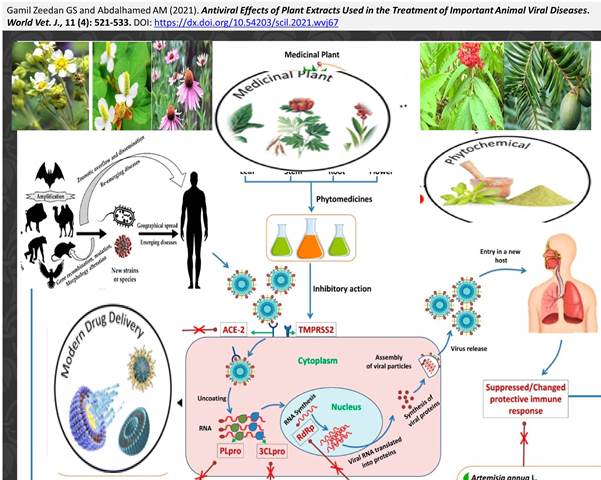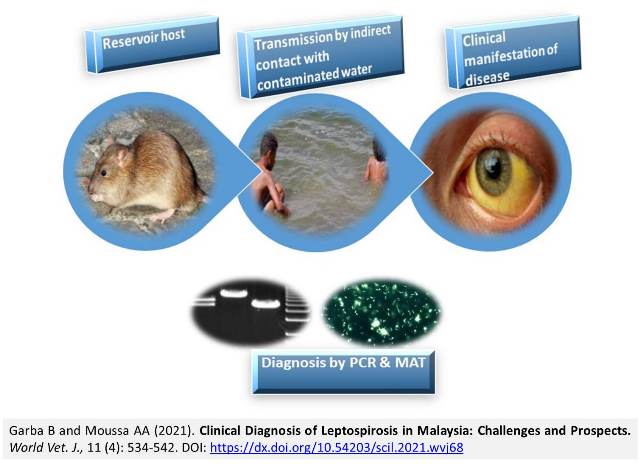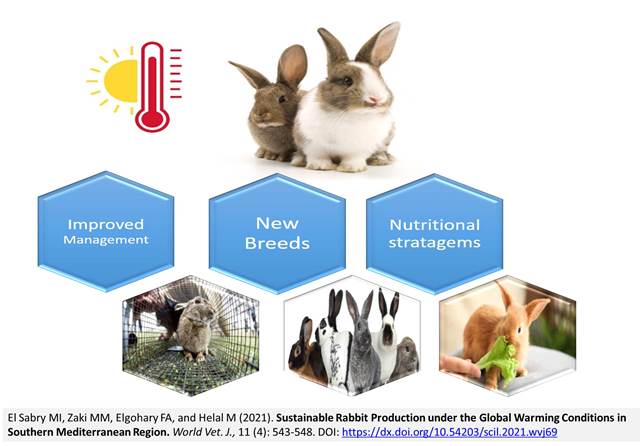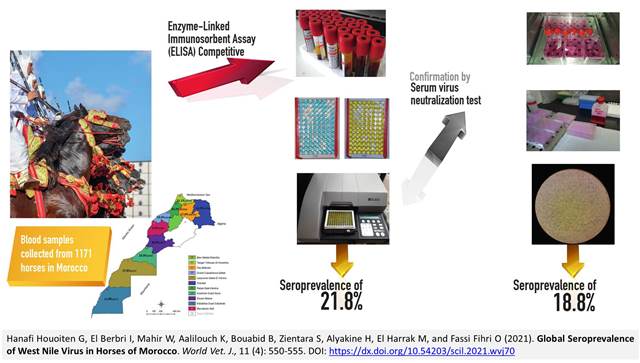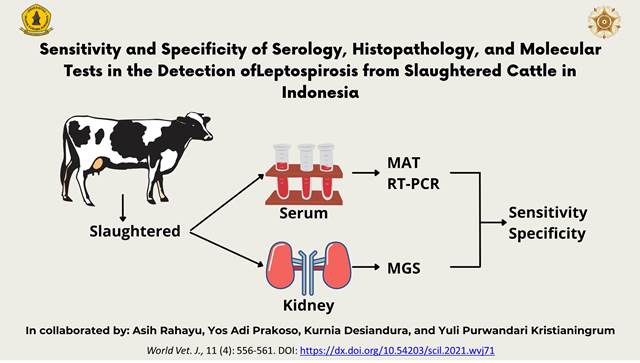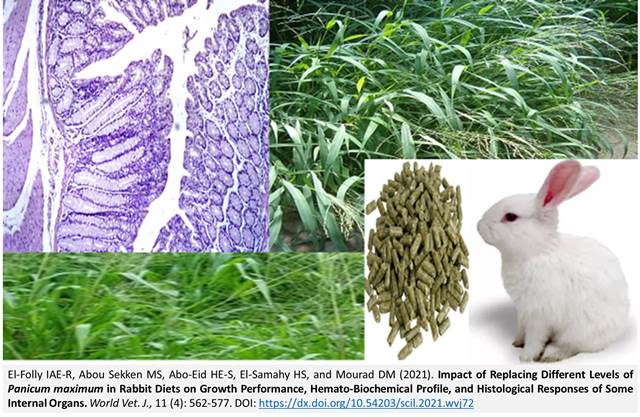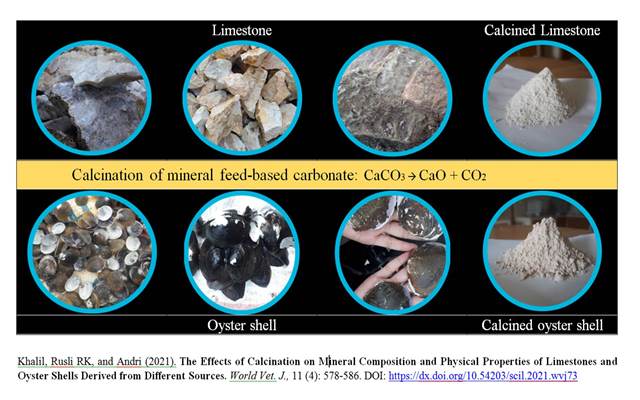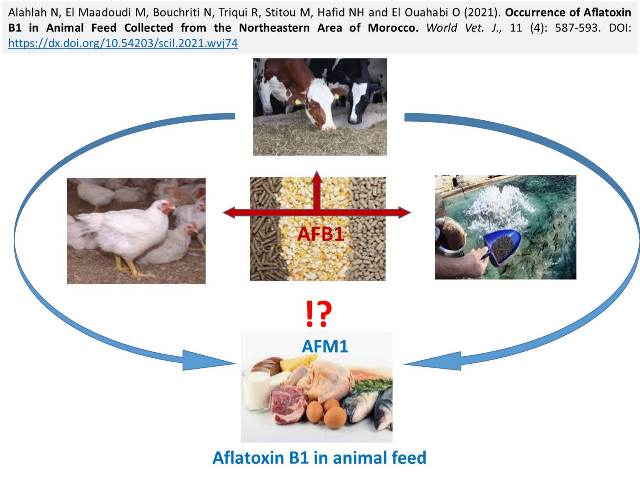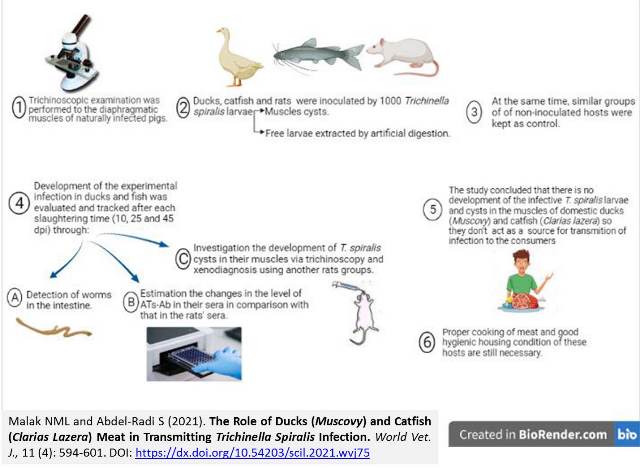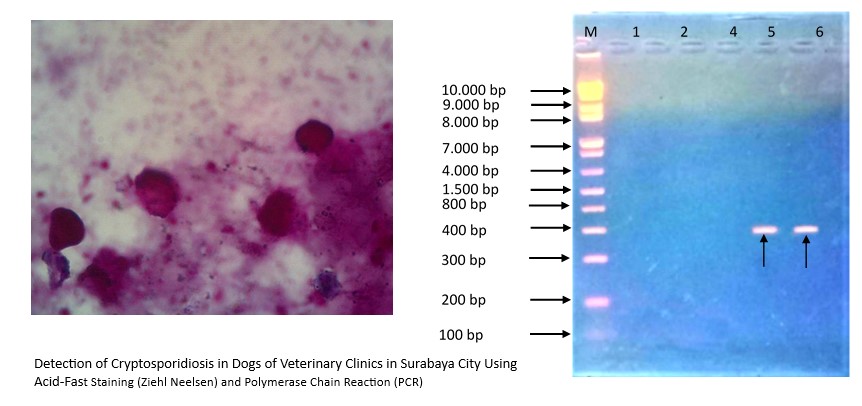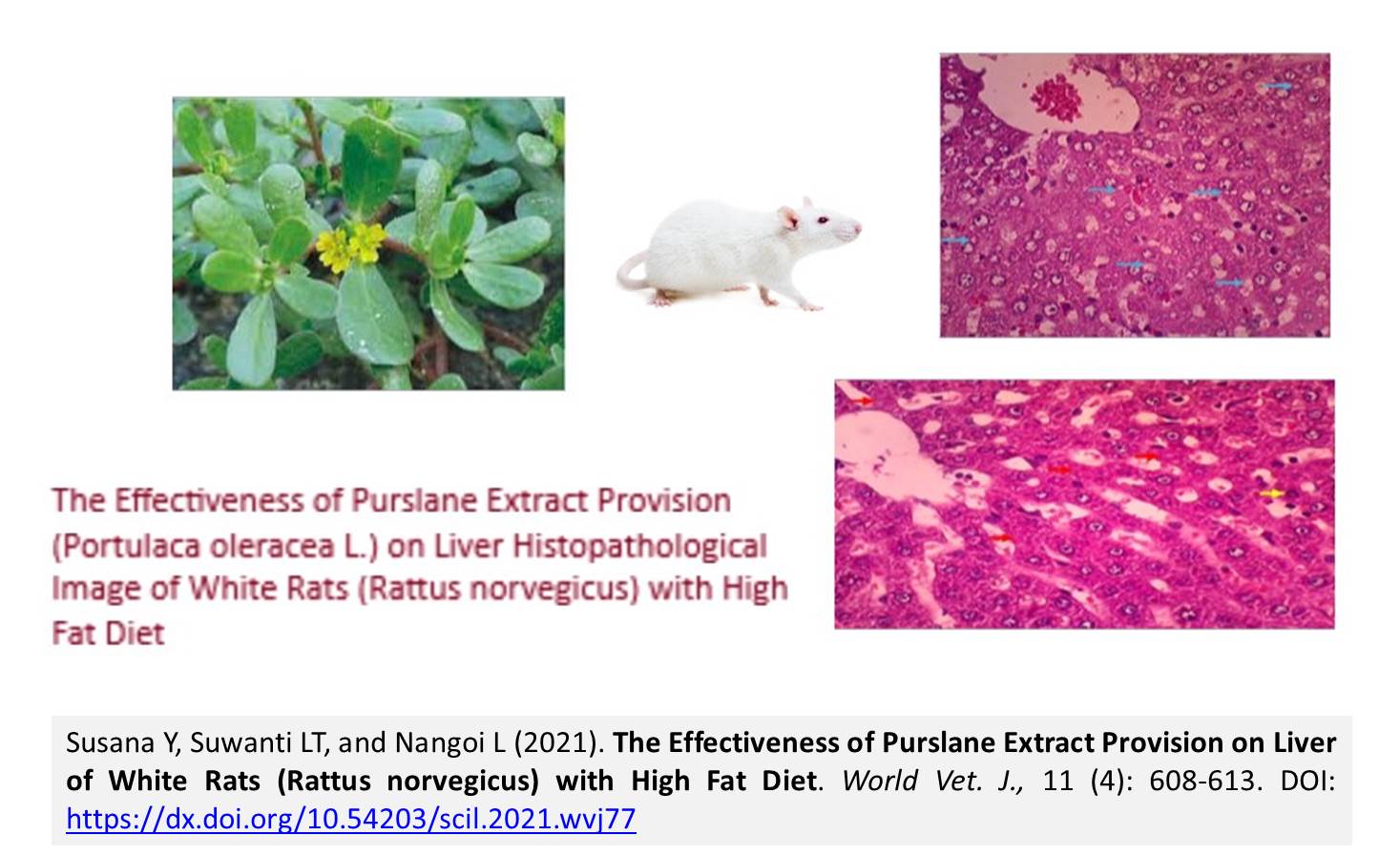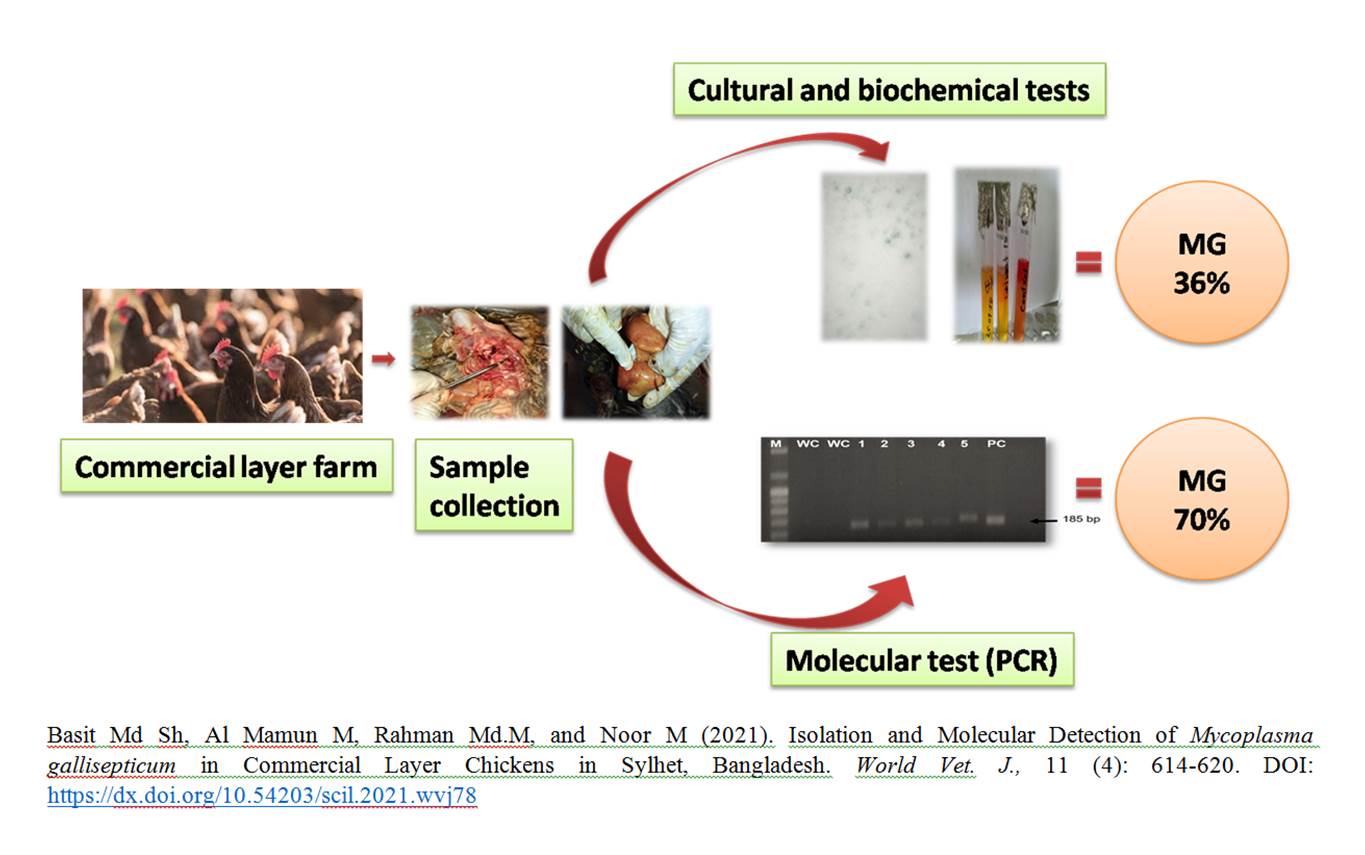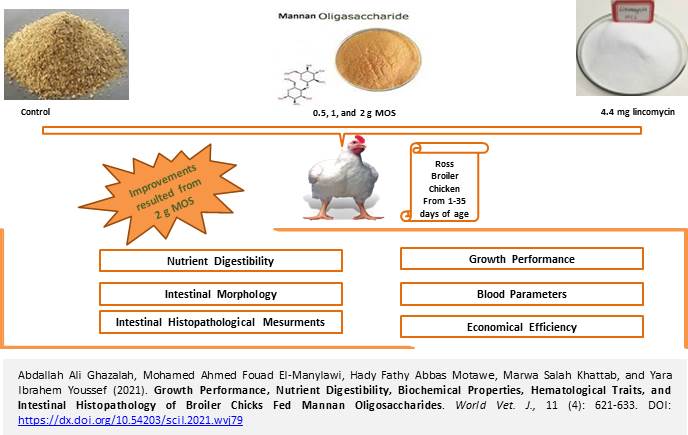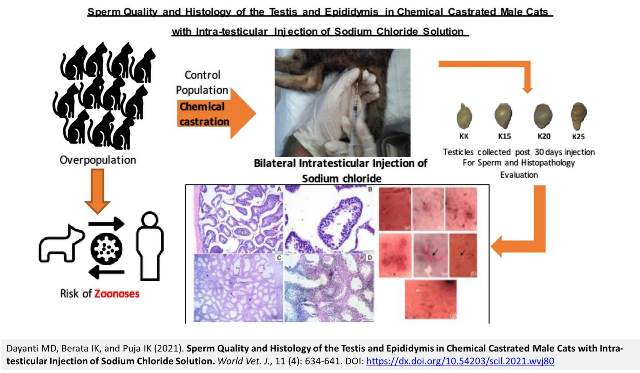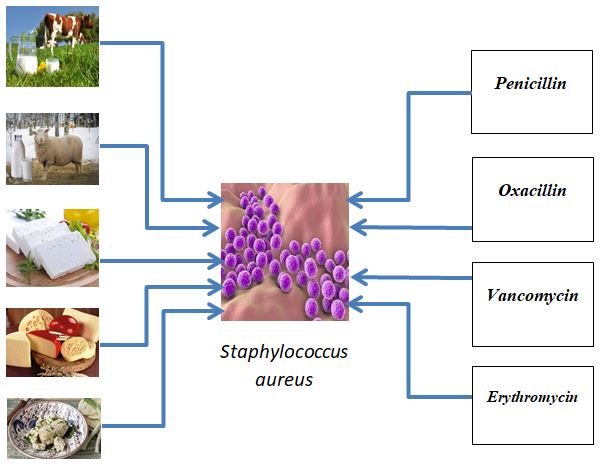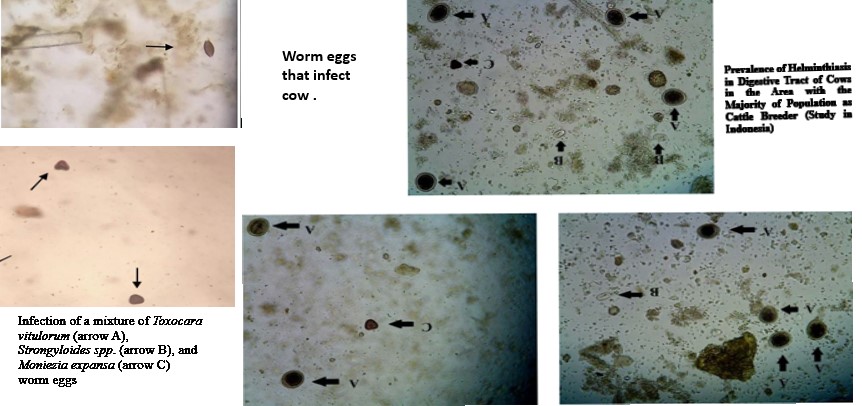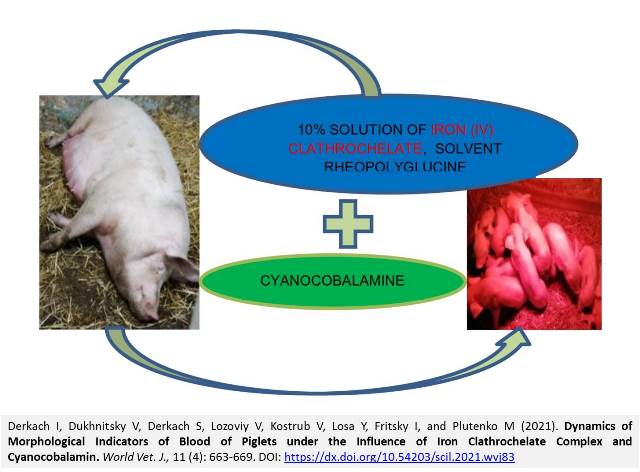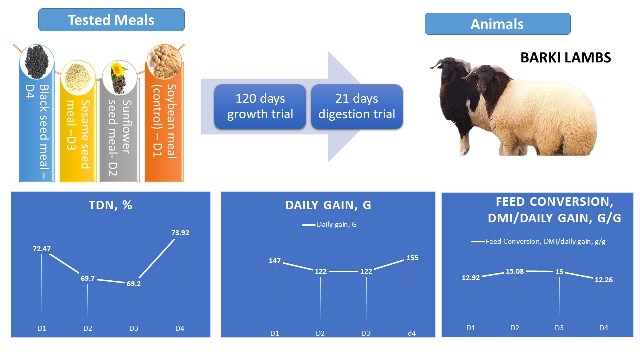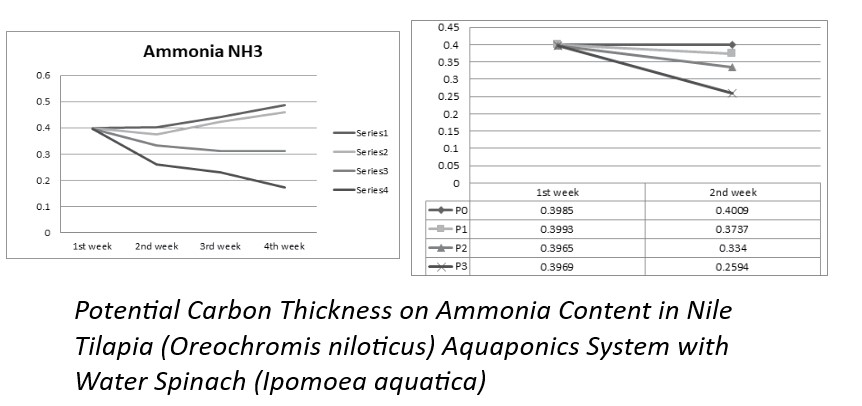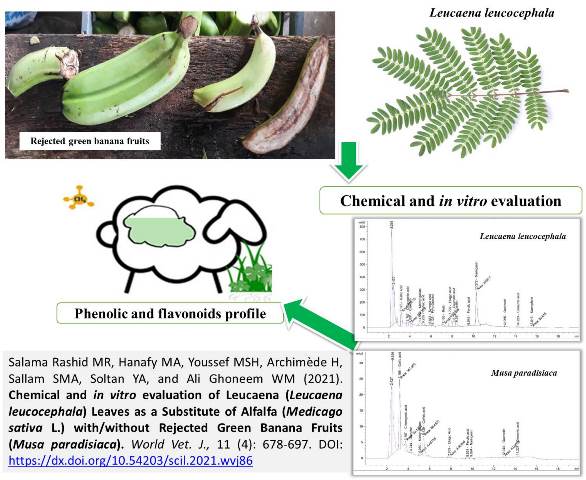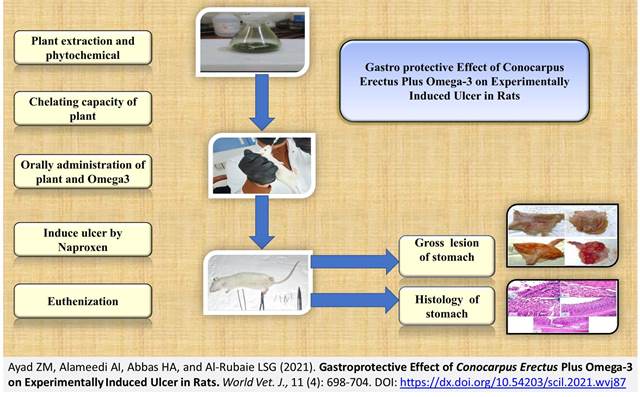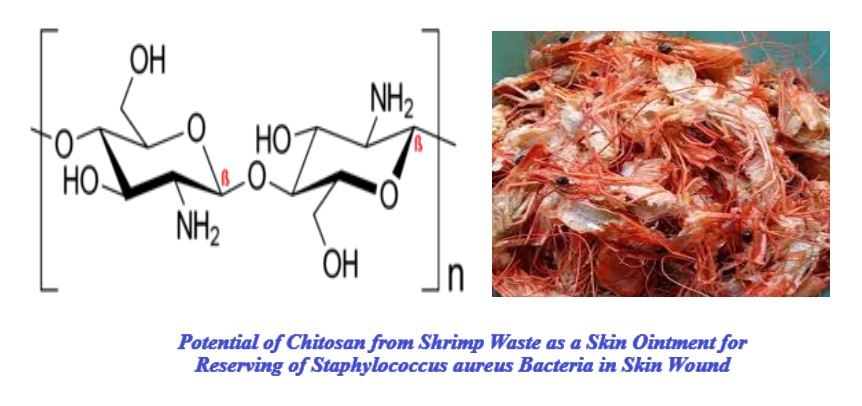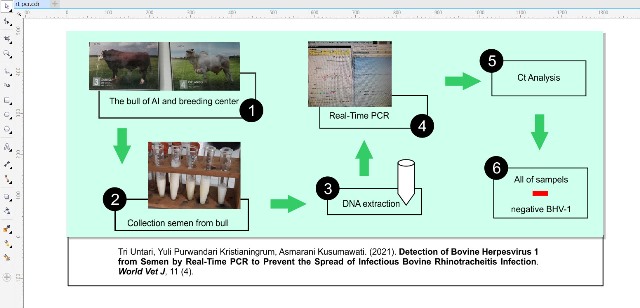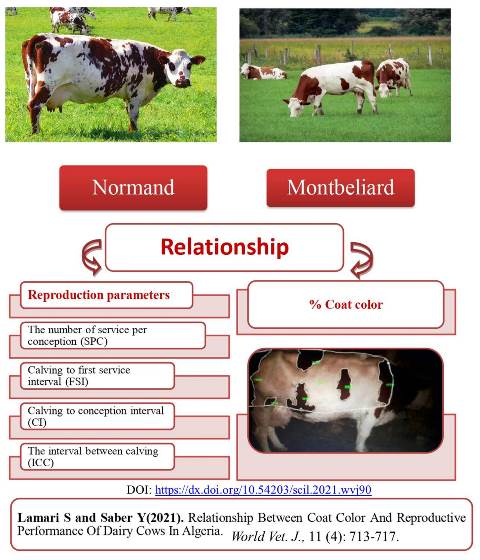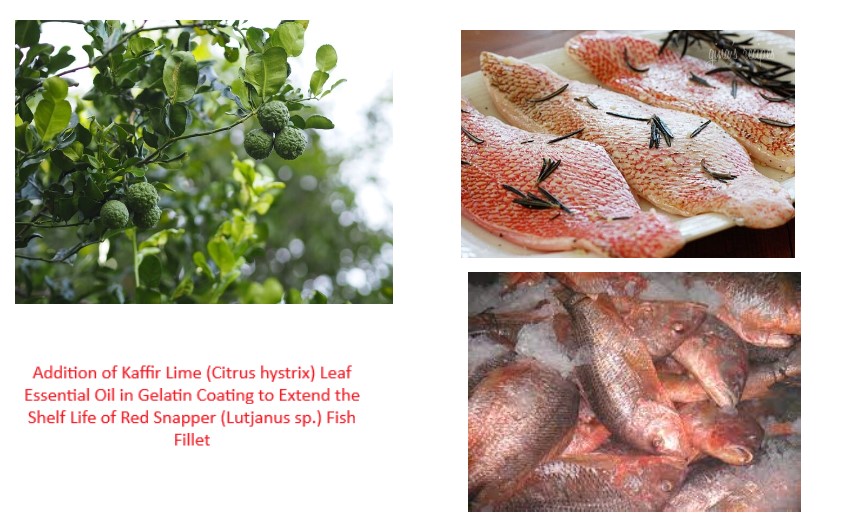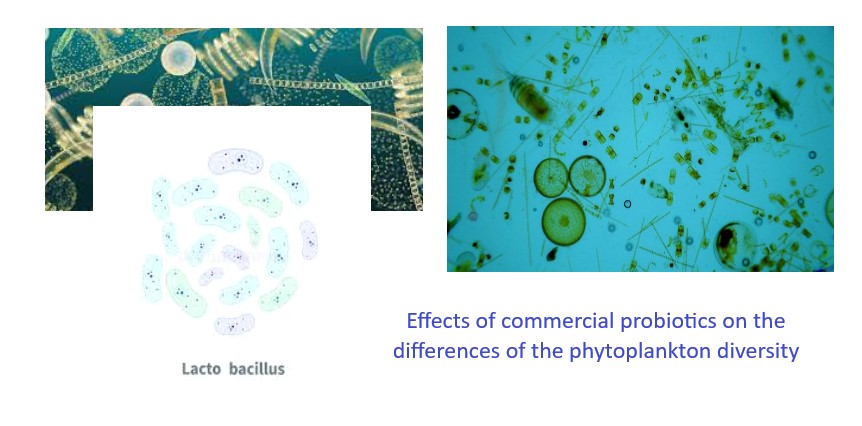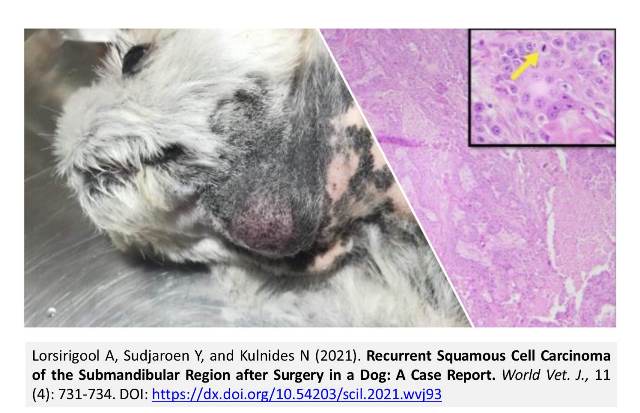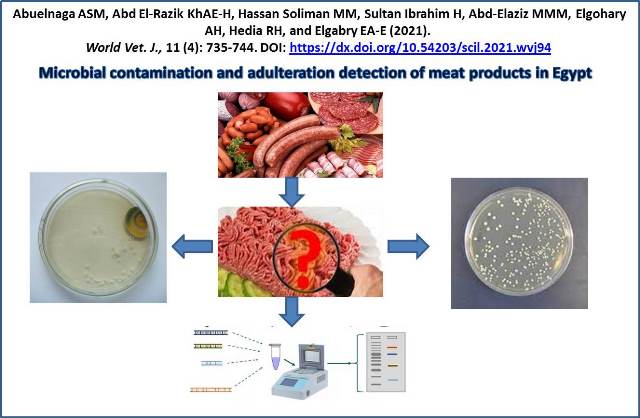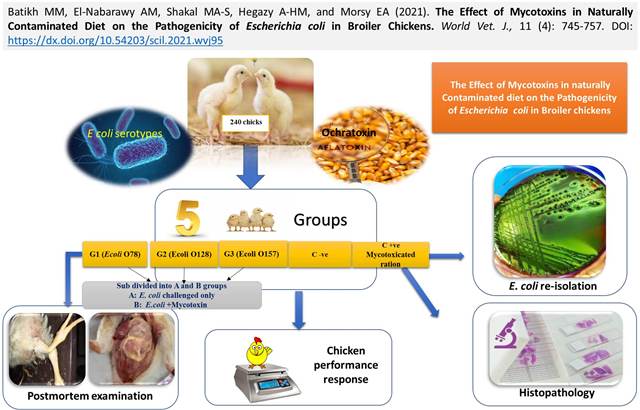Previous issue | Next issue | Archive
Volume 11 (4); December 25, 2021 [Booklet] [EndNote XML for Agris]![]()
Download high resolution as pdf
Review
Antiviral Effects of Plant Extracts Used in the Treatment of Important Animal Viral Diseases
|
|
Gamil Zeedan GS and Abdalhamed AM.
World Vet. J. 11(4): 521-533, 2021; pii:S232245682100067-11
DOI: https://dx.doi.org/10.54203/scil.2021.wvj67
ABSTRACT: The goal of this review was to highlight some plant species that have significant antiviral activity against DNA and RNA viruses in vitro and in vivo although more research is needed to address safety issues, drug interactions, and the possibility of using them in combination with other natural products. Viral infection plays an important role in human and animal diseases. Although there have been advances in immunization and antiviral drugs, there is still a lack of protective vaccines and effective antiviral drugs in human and veterinary medicine. The lack of effective antivirals necessitates the search for new effective antiviral compounds. Plants are naturally gifted at synthesizing antiviral compounds. They are rich sources of phytochemicals with different biological activities, including antiviral activities as a result of advanced analytical chemistry, standard virus assays, and development of standardization and extraction methods. Plant extracts have a wide variety of active compounds, including flavonoids, terpenoids, lignans, sulphides, polyphenolics, coumarins, saponins, furyl compounds, alkaloids, polyines, thiophenes, proteins, and peptides. Moreover, certain volatile oils have indicated a high level of antiviral activity. Replication, assembly, and release, as well as targeting virus host-specific interactions capable of inhibiting several viruses, could help the development of broad-spectrum antivirals for the prevention and control of viral pathogens. The in vitro antiviral activities of Erythroxylum deciduum, Lacistema hasslerianum (chodat), Xylopia aromatica, Heteropteris aphrodisiaca, Acacia nilotica (gum arabic tree), Lippia graveolens (Guettarda angelica (Velvetseed), Prunus myrtifolia, and Symphyopappus plant extracts can inhibite viral replication, and interfer with the early stages of viral adsorption of DNA viruses. However, Boesenbergia rotunda plant extracts have inhibited RNA viruses. A potent anti-SARS-CoV-2 inhibitor with B. rotunda extract and panduratin A after viral infection drastically suppresses SARS-CoV-2 infectivity in Vero E6 cells.
Keywords: Bovine herpes virus type-1, Bovine infectious, Bovine infectious cell protein 4, Buffalo pox virus, Foot-and-mouth disease, Plant extracts, Rotaviruses
[Full text-PDF] [XML] [Google Scholar] [Crossref Metadata] [Scopus ID: 85123236120] [Export from ePrint] [How to Cite]
Clinical Diagnosis of Leptospirosis in Malaysia: Challenges and Prospects
|
|
Garba B and Moussa AA.
World Vet. J. 11(4): 534-542, 2021; pii:S232245682100068-11
DOI: https://dx.doi.org/10.54203/scil.2021.wvj68
ABSTRACT: Leptospirosis is a neglected emerging zoonosis occurring both in urban environments and rural regions worldwide. During occupational and recreational activities, individuals who directly or indirectly contact the urine of infected animals are at a high risk of infection. Southeast Asia is reported to have the highest incidence of leptospirosis in the world. The disease is endemic in Malaysia and has consistently caused outbreaks among humans with severe outcomes. Early diagnosis is vital for commence treatment thereby minimizing the harmful effects of the disease. It also allows the implementation of measures to control the spread to humans and the environment. In this article, an attempt was made to review the current diagnostic methods including challenges faced by healthcare service providers during the diagnosis of acute cases, as well as the emerging technologies used for early and accurate diagnosis. The review also highlighted innovative ideas that can be integrated into developing practical solutions, including the crucial roles of the patients, reservoir hosts, and the environments that harbor the bacteria.
Keywords: Emerging zoonoses, Laboratory diagnosis, Leptospirosis, Malaysia, Neglected tropical disease
[Full text-PDF] [XML] [Google Scholar] [Crossref Metadata] [Scopus ID: 85123261265] [Export from ePrint] [How to Cite]
Sustainable Rabbit Production under the Global Warming Conditions in Southern Mediterranean Region
|
|
El Sabry MI, Zaki MM, Elgohary FA, and Helal M.
World Vet. J. 11(4): 543-548, 2021; pii:S232245682100069-11
DOI: https://dx.doi.org/10.54203/scil.2021.wvj69
ABSTRACT: There is still a wide gap between meat demand and meat production in Egypt. This gap is becoming larger due to the direct and indirect impacts of global warming that negatively influence the grazing area and the performance of livestock. In this context, rabbits are considered as an alternative source for animal-origin meat. In the Southern Mediterranean region, the most obvious problem encountering rabbit production is the hot waves during the summer, especially during the last decades. The narrow thermo-neutral zone of rabbits makes the high temperature hinder the success of commercial production. Different strategies may assist rabbits in coping with heat stress, which are reviewed in the current study, including the improved management practices, development of new breeds, and implementation of different nutritional strategies.
Keywords: Global warming, Rabbit production, Southern Mediterranean
[Full text-PDF] [XML] [Google Scholar] [Crossref Metadata] [Scopus ID: 85123236981] [Export from ePrint] [How to Cite]
Global Seroprevalence of West Nile Virus in Horses of Morocco
|
|
Hanafi Houoiten G, El Berbri I, Mahir W, Aalilouch K, Bouabid B, Zientara S, Alyakine H, El Harrak M, and Fassi Fihri O.
World Vet. J. 11(4): 549-555, 2021; pii:S232245682100070-11
DOI: https://dx.doi.org/10.54203/scil.2021.wvj70
ABSTRACT: West Nile Fever (WNF) is a viral emerging mosquito-borne disease causing mortality and morbidity with varying severity (from mild fever to severe neuroinvasive disease) among human and animal populations in many parts of the world. The current study aimed to confirm the virus circulation and assess the disease seroprevalence in horses of Morocco. A sample of 1171 healthy non-vaccinated (against-WNF) horses, taken from 11 (out of 12) regions of the country during July-December 2016, was primarily tested using competitive ELISA assay (cELISA). All cELISA-reactive positive and doubtful sera (n= 269) were further tested by virus neutralization test (VNT). The results of cELISA test revealed an overall WNF seroprevalence in 21.8% (255/1171) of sampled horses. This rate decreased to 18.8% (220/1171) after the confirmation of VNT. The WNF seroprevalence in the current study varied significantly by age, gender, and breed of the tested horses. Indeed, the higher seropositivity rates were found in the oldest (27.7%), female (22.0%), and saddle (32.1%) horses. However, the origin of animals did not show any significant effect on the West Nile virus infection. The obtained results of the present study, therefore, provided serological and epidemiological evidence of the endemicity of the WNV in horse populations of Morocco.
Keywords: Emerging disease, Morocco, Mosquito-borne disease, Seroprevalence, West Nile virus.
[Full text-PDF] [XML] [Google Scholar] [Crossref Metadata] [Scopus ID: 85123258201] [Export from ePrint] [How to Cite]
Sensitivity and Specificity of Serology, Histopathology, and Molecular Tests in the Detection of Leptospirosis from Slaughtered Cattle in Indonesia
|
|
Rahayu A, Prakoso YA, Desiandura K, and Kristianingrum YP.
World Vet. J. 11(4): 556-561, 2021; pii:S232245682100071-11
DOI: https://dx.doi.org/10.54203/scil.2021.wvj71
ABSTRACT: Leptospira spp. is a pathogenic bacteria that causes leptospirosis in humans and cattle. The World Health Organization (WHO) recommends the microscopic agglutination test (MAT) as the laboratory gold standard in the detection of leptospirosis. However, the limitation of MAT triggers the laboratory technicians to develop alternative laboratory tests against leptospirosis. The current study aimed to compare the sensitivity and specificity of histopathology special stain using modified Gram staining (MGS) and molecular test using reverse transcriptase-polymerase chain reaction (RT-PCR), compared to the MAT for Leptospira spp. detection in cattle. This study used a total of 38 serum and 38 kidney samples from the cattle slaughtered in the Sidoarjo slaughterhouse, Indonesia. The collected serum samples were tested against MAT and RT-PCR. The kidneys were processed for histopathology using MGS. The result indicated that 16 (42.10%) of the tested samples were positive against MAT, 6 (15.78%) were positive against MGS, and 18 (47.36%) were positive against RT-PCR. The RT-PCR indicated better sensitivity and lower specificity, compared to MAT and MGS. The findings revealed that the RT-PCR is an appropriate laboratory test for detecting cattle leptospirosis with better sensitivity and specificity. Therefore, this method can be suggested to substitute MAT and overcome its limitations.
Keywords: Cattle, Histopathology, Leptospira spp., Molecular, Serology
[Full text-PDF] [XML] [Semantic Scholar] [Crossref Metadata] [Scopus ID: 85123260610] [Export from ePrint] [How to Cite]
Impact of Replacing Different Levels of Panicum maximum in Rabbit Diets on Growth Performance, Hemato-Biochemical Profile, and Histological Responses of Some Internal Organs
|
|
El-Folly IAE-R, Abou Sekken MS, Abo-Eid HE-S, El-Samahy HS, and Mourad DM.
World Vet. J. 11(4): 562-577, 2021; pii:S232245682100072-11
DOI: https://dx.doi.org/10.54203/scil.2021.wvj72
ABSTRACT: There has been an interest in alternative sources in rabbit feeding. Therefore, the current study aimed to estimate the health status, growth performance, hemato-biochemical, and histological picture of some important internal organs in growing Newziland rabbits as a result of replacing different levels of Panicum maximum (PM) in its pelleted diet. A total of 35 weaned rabbits (20 males and 15 females) aged 5 weeks were purchased with an average body weight of 839.7 ± 7.05 g and 771.20 ± 9.19 g for males and females, respectively. Randomly, five equal rabbit groups were formed (7 rabbits in each group). The first group (control) was fed a basal diet without PM. The second, third, fourth, and fifth groups were fed pelleted diets containing PM with a replacing percent of 25%, 50%, 75%, and 100% of clover hay, respectively. All groups were fed ad libitum of pelleted feed for two months. The blood was aspirated individually three times, including at the beginning of the experiment (as zero time), after one month, and at the end of the experiment, respectively. The whole blood was used for the measurement of hemoglobin concentration, hematocrit percentage, erythrocytes, and total leukocyte counts. At the experimental end, in each group, 3 male rabbits were sacrificed and their internal organs including liver, kidney, cecum, and rectum were collected for histopathology. The live body weight was significantly affected by sex where males were heavier than females, also feed conversion ratio, growth rate, and feed intake were significantly affected by feeding on different levels of PM. Blood hemoglobin, hematocrit, and the total leukocytic count had a non-significant effect while the erythrocyte count increased significantly in all experimental groups. There were insignificant changes in plasma total protein, albumin, globulin, ALT, AST, creatinine, and glucose concentrations when different levels of PM were added. furthermore, the plasma total cholesterol and triglycerides were significantly decreased in rabbits fed PM, 75% and 100% when compared with 25%, 50%, and control groups. Finally, replacement PM instead of clover hay in pelleted diets till 75% was found to be the safety and optimum percentage for biological and healthy rabbits.
Keywords: Growth, Hemato-biochemical, Histopathology, Panicum maximum, Rabbits
[Full text-PDF] [XML] [Google Scholar] [Crossref Metadata] [Scopus ID: 85123261671] [Export from ePrint] [How to Cite]
The Effects of Calcination on Mineral Composition and Physical Properties of Limestones and Oyster Shells Derived from Different Sources
|
|
Khalil, Rusli RK, and Andri.
World Vet. J. 11(4): 578-586, 2021; pii:S232245682100073-11
DOI: https://dx.doi.org/10.54203/scil.2021.wvj73
ABSTRACT: Limestones and oyster shells are normally used in raw or roasted meal form in the livestock diet. Calcination is intended to improve the mineral concentration and physical characteristics of limestones and oyster shells which vary based on different chemical compositions, textures, and impurities of their types and habitats. The present research aimed to study the effects of calcination on mineral composition and the physical properties of limestones and oyster derived from various sources. Limestone samples from three local limestone mining and oyster shell samples from three shellfish species were calcined by burning at a temperature of 800-1000°C. The calcined products were analyzed for mineral content (Ca, P, Mg, Cu, Zn, and Mn), physical properties (bulk density, tapped density, specific density, and angle of repose), and particle size. Results indicated that calcination had no significant effect on Ca and P concentrations but reduced micro mineral concentration. Limestones had a higher Mg concentration than that of oyster shells, and calcination increased Mg concentration. Calcined oyster shells had higher densities, percentages of fine particles, and lower angles of response. The results suggested that the type of limestones and oyster shells could determine their thermal decomposition properties.
Keywords: Calcination, Limestone, Mineral composition, Oyster shell, Physical property
[Full text-PDF] [XML] [Semantic Scholar] [Crossref Metadata] [Scopus ID: 85123243929] [Export from ePrint] [How to Cite]
Occurrence of Aflatoxin B1 in Animal Feed Collected from the Northeastern Area of Morocco
|
|
Alahlah N, El Maadoudi M, Bouchriti N, Triqui R, Stitou M, Hafid NH and El Ouahabi O.
World Vet. J. 11(4): 587-593, 2021; pii:S232245682100074-11
DOI: https://dx.doi.org/10.54203/scil.2021.wvj74
ABSTRACT: The carry-over of contaminants from feed to animal products is an important issue in the animal production chain, therefore, the quality control of those animal products should include the control of the animal feed. The current study was carried out to assess the contamination levels of three types of animal feed (dairy animal feed, poultry feed, and fish feed) by Aflatoxin B1. A total of 68 animal feed samples were collected from the Northeastern Moroccan area (Tangier-Tétouan-AL Hoceima). The samples were extracted with a mixture of acetone/water. The sample extractions were filtered, diluted with phosphate-buffered saline, and applied to an immunoaffinity column. Aflatoxin B1 was eluted with methanol then analyzed by high-performance liquid chromatography with fluorescence detection, after post-column photochemical derivatization. The analytical results for the level of Aflatoxin B1 in the animal feed samples revealed an average presence of 44.12% for all analyzed samples. The concentrations were between 1.02 and 13.59 µg/Kg, with a mean value of 4.08 ± 3.11 µg/Kg. The results indicated that there was a significant difference across the three types of animal feeds regarding the concentrations of Aflatoxin B1.
Keywords: Aflatoxin B1, Animal feed, HPLC, Morocco, Statistical data
[Full text-PDF] [XML] [Semantic Scholar] [Crossref Metadata] [Scopus ID: 85123254057] [Export from ePrint] [How to Cite]
The Role of Ducks (Muscovy) and Catfish (Clarias Lazera) Meat in Transmitting Trichinella Spiralis Infection
|
|
Malak NML and Abdel-Radi S.
World Vet. J. 11(4): 594-601, 2021; pii:S232245682100075-11
DOI: https://dx.doi.org/10.54203/scil.2021.wvj75
ABSTRACT: Trichinellosis is a worldwide zoonotic food-borne disease that causes public health problems. The present study investigated the role of domestic ducks (Muscovy) and catfish (Clarias lazera) in transmitting Trichinella spiralis infection in Egypt. Ducks, fish, and rats were inoculated by high doses of Trichinella spiralis (T. Spiralis) larvae in naturally infected muscles of pigs and by free larvae extracted from artificial digestion. Both methods failed to develop an infection in ducks. No worms or cysts could be detected in ducks slaughtered 10, 25, and 45 days after inoculation. Moreover, there was no significant increase in the mean ELISA optical density (OD) value, compared to the control non-inoculated ducks. Inoculation of fish resulted in a significant increase in the mean ELISA OD value, compared to the control non-inoculated fish. This elevation was associated with the temporary detection of a few adult worms in the intestine of these fish which decreased with time till disappeared 45 days after inoculation but a non-significant increase was observed, compared to that obtained in the inoculated rats at the same stages. A large number of T. spiralis adult worms and cysts associated with a significant increase in the mean ELISA OD were recorded in the inoculated rats. Infection of rats (xenodiagnosis) by muscles collected from the inoculated ducks or fish failed to induce infection or elevation in the level of anti-T. spiralis antibodies (ATs-Ab) in their sera. In conclusion, Muscovy ducks and Clarias lazera could not be infected by T. spiralis in their muscles and the consumption of their meat could not transmit this infection to consumers in Egypt. However, proper cooking of meat is still necessary to avoid infection with other species.
Keywords: Clarias lazera, Ducks, ELISA, Trichinella spiralis
[Full text-PDF] [XML] [Semantic Scholar] [Crossref Metadata] [Scopus ID: 85123247002] [Export from ePrint] [How to Cite]
Detection of Cryptosporidiosis in Dogs of Veterinary Clinics in Surabaya City Using Acid-Fast Staining and PCR
|
|
Mufa RMD, Lastuti NDR, Legowo D, and Mufasirin.
World Vet. J. 11(4): 602-607, 2021; pii:S232245682100076-11
DOI: https://dx.doi.org/10.54203/scil.2021.wvj76
ABSTRACT: The need for maintaining pets, such as dogs, is increasing along with the human population. When individuals keep dogs as their pets, they must be aware of disease transmission from dogs. One of the disease agents transmitted from pets to their owners is Cryptosporidium spp. causing cryptosporidiosis. The aim of the present study was to detect Cryptosporidium spp. infection in dogs through a fecal examination using the acid-fast staining method (Ziehl Neelsen) confirmed with the molecular examination of Polymerase Chain Reaction (PCR). Detection of Cryptosporidium sp. in feces of dogs was set up by using an acid-fast staining method. Positive results of the acid-fast staining were further confirmed using PCR. Polymerase Chain Reaction used primary AB210854 specific to the Cryptosporidium canis and S139-S141 genes which were specific primary for the Cryptosporidium parvum gene. Results of the acid-fast staining showed that 80% of the samples (40 samples from total samples) were infected with Cryptosporidium spp. Further detection using PCR showed that four samples were positive for Cryptosporidium canis infection, and two samples showed positive results of Cryptosporidium parvum infection. Dog samples were mostly infected with Cryptosporidium spp. including Cryptosporidium canis and Cryptosporidium parvum through a fecal examination using acid-fast staining and PCR.
Keywords: Acid-fast staining, Cryptosporidium spp., Dogs, PCR
[Full text-PDF] [XML] [Google Scholar] [Crossref Metadata] [Scopus ID: 85123267113] [Export from ePrint] [How to Cite]
The Effectiveness of Purslane Extract Provision on Liver of White Rats (Rattus norvegicus) with High Fat Diet
|
|
Susana Y, Suwanti LT, and Nangoi L.
World Vet. J. 11(4): 608-613, 2021; pii:S232245682100077-11
DOI: https://dx.doi.org/10.54203/scil.2021.wvj77
ABSTRACT: Most animal owners provide fatty food with high cholesterol level that exceeds the needs of their pets. The pattern of giving a high-fat diet causes interference with the cholesterol synthesis in the body. It can damage the liver by causing fatty degeneration, hepatic cirrhosis, and eventually necrosis of the liver. The purpose of the current study was to determine the effectiveness of Purslane extract (Portulaca oleracea L.) on the liver histopathological image of white rats (Rattus norvegicus) with a high-fat diet. The current study used an experimental method with a completely randomized design on 20 males white mouses (Rattus norvegicus) divided into five treatment groups. There were two control groups, the first group received standard feed (Pellet) and Carboxymethyl Cellulose Sodium 1%, while the second was given standard feed and a high-fat diet. Three treatment groups which included P1, P2, P3 were given standard feed, a high-fat diet, and purslane extract solution with 54 mg/day, 108 mg/day, and 216 mg/day, respectively. Research results from the mean rank of fatty degeneration which was measured using the Kruskal Wallis test presented significant differences, and the results from the mean of fatty degeneration using the Mann Whitney test did not indicate any significant difference. Liver cell necrosis from the two tests presented a significant difference. Purslane extract (Portulaca oleracea L.) was confirmed to be effective in reducing or decreasing hepatocyte cell damage after receiving a high-fat diet.
Keywords: Fatty degeneration, High-fat diet, Liver necrosis, Portulaca oleracea L., White rat liver
[Full text-PDF] [XML] [Google Scholar] [Crossref Metadata] [Scopus ID: 85123235687] [Export from ePrint] [How to Cite]
Isolation and Molecular Detection of Mycoplasma gallisepticum in Commercial Layer Chickens in Sylhet, Bangladesh
|
|
Basit Md Sh, Al Mamun M, Rahman Md.M, and Noor M.
World Vet. J. 11(4): 614-620, 2021; pii:S232245682100078-11
DOI: https://dx.doi.org/10.54203/scil.2021.wvj78
ABSTRACT: Mycoplasma gallisepticum induced poultry diseases are associated with a huge economic crisis and have a considerable impact on the poultry industry worldwide. The aim of the current study was to isolate and perform molecular detection of MG circulating pathogenic strain in the commercial layer farms in the Sylhet district of Bangladesh. The entire study was conducted from January 2018 to January 2019 at three Upazilas of Sylhet district in Bangladesh. A total of 50 dead layer chickens (indicating signs of respiratory distress before death) were collected randomly from 15 different layer farms. The tissue samples, such as air sacs, trachea, and lungs, were taken from suspected dead chickens. Both cultural and PCR-based techniques were applied to identify Mycoplasma from tissue samples. The conventional PCR technique was implemented to amplify 185 bp DNA fragments for the MG. Out of 50 samples, 36% (18/50) and 70% (35/50) of MG were identified by cultural method and PCR, respectively. Based on the results of the study, it can be concluded that PCR is an easier, more sensitive, and less time-consuming method for the early diagnosis of MG in chickens, compared to cultural isolation and hence can lower the economic burden to poultry farmers caused by this disease.
Keywords: Culture, Layer chicken, Mycoplasma gallisepticum, PCR
[Full text-PDF] [XML] [Google Scholar] [Crossref Metadata] [Scopus ID: 85123241727] [Export from ePrint] [How to Cite]
Growth Performance, Nutrient Digestibility, Biochemical Properties, Hematological Traits, and Intestinal Histopathology of Broiler Chicks Fed Mannan Oligosaccharides
|
|
Ghazalah AA, Fouad El-Manylawi MA, Motawe HFA, Khattab MS, and Youssef YI.
World Vet. J. 11(4): 621-633, 2021; pii:S232245682100079-11
DOI: https://dx.doi.org/10.54203/scil.2021.wvj79
ABSTRACT: Antibiotics as growth promoters in poultry diets are currently restricted, so other feed additives, such as prebiotics and probiotics, have been suggested as an antibiotics alternative to improve the performance and gut health of poultry. The current experiment was conducted to study the effects of adding Mannan oligosaccharides (MOS) as a potential replacement for an antibiotic on productive performance, nutrient digestibility, some blood parameters, and caecal microbiota of broiler chickens. For conducting the current research experiment, a total of 180 one–day old Ross broiler chicks were randomly divided into one control group fed a basal diet and four dietary treatments with six replicates for each treatment. The treatment groups were fed a basal diet supplemented with different levels of MOS 0.5, 1, and 2 g/Kg diet and Lincomycin 4.4 mg/Kg diet during 35 days of the feeding trial. With exception of the growing period, the group fed a basal diet supplemented with 2 g MOS/Kg feed had considerably higher body weight and weight gain, while having the lowest feed consumption and best feed conversion ratio compared to the other treatment groups, during all experimental periods. Moreover, dietary supplementation of MOS resulted in a significant decrease in the counts of caecal E. coli and Enterococcus, while Lactobacillus and Yeast bacteria counts were significantly higher, compared to non-supplemented groups. Broiler chicks having a 2 g MOS/kg diet recorded lower values of cholesterol, low-density lipoprotein (LDL), urea, and liver enzymes, including Aspartate transaminase (AST) and Alanine aminotransferase (ALT), while they recorded significantly higher high-density lipoprotein (HDL), compared to the other experimental groups. Group treated with MOS 2 g/Kg feed improved digestibility of crude protein, ether extract, crude fiber, nitrogen-free extract, and organic matter, compared to the control group, Additionally, MOS supplementation also increased the intestinal villi length, width, and crypt depth and decreased intestinal inflammation, compared to the control group. In conclusion, supplementation of MOS at 2 g/kg diet improved growth performance, digestibility, and blood parameters without having adverse effects on the intestine of broiler chickens, comparable to the Lincomycin.
Keywords: Broilers, Digestibility, Growth Performance, Lincomycin, Mannan oligosaccharides
[Full text-PDF] [XML] [Google Scholar] [Crossref Metadata] [Scopus ID: 85123234781] [Export from ePrint] [How to Cite]
Sperm Quality and Histology of the Testis and Epididymis in Chemical Castrated Male Cats with Intra-testicular Injection of Sodium Chloride Solution
|
|
Dayanti MD, Berata IK, and Puja IK.
World Vet. J. 11(4): 634-641, 2021; pii:S232245682100080-11
DOI: https://dx.doi.org/10.54203/scil.2021.wvj80
ABSTRACT: The high population of feral cats in Bali, Indonesia, could be a problem associated with cat welfare and the risk of zoonotic diseases. Gonadectomy or male castration is an option for population control; however, there would be more economical ways to reach this goal. Sterilization using chemicals is an alternative to the surgical method of castration as it is reasonably priced, activated in a short time, and does not affect animal activity after the chemical administration. The present study aimed to evaluate intratesticular injection of Sodium chloride as an agent of chemosterilants in male cats. In the current study, 16 healthy male cats aged nearly one year old were randomly selected. The male cats were allocated into four groups containing four cats in each. Group 1 (control) received bilateral intratesticular injection with 0.25 mL normal saline solution containing 2% Lidocaine. The cats in groups 2, 3, and 4 received bilateral intratesticular injection of 0.25 mL Sodium chloride solution containing 2% Lidocaine with a concentration of 15%, 20%, and 25%, respectively. At the end of the study (after 30 days of injection), the cats were castrated and their testes were removed for sperm quality and histopathological evaluation. The results of the present study indicated that intratesticular injection of Sodium chloride significantly decreased the motility and viability rates, and increased the abnormalities of the sperms. Histopathological studies revealed marked depletion of spermatozoa in the testes and seminiferous tubular degeneration, seminiferous tubular atrophy, and epithelial cell vacuolation. In conclusion, the injection of 20-25% solution of Sodium chloride in testes had the potential as a chemosterilant for chemical sterilization in cats.
Keywords: Cat, Histopathology, Sodium chloride, Sperm quality
[Full text-PDF] [XML] [Google Scholar] [Crossref Metadata] [Scopus ID: 85123243373] [Export from ePrint] [How to Cite]
Phenotypic and Genotypic Characterization of Methicillin, Vancomycin, and Erythromycin-resistant Staphylococcus aureus Isolated from Milk and Dairy Products
|
|
Omara ShT, Hakim AS, and Bakry MA.
World Vet. J. 11(4): 642-657, 2021; pii:S232245682100081-11
DOI: https://dx.doi.org/10.54203/scil.2021.wvj81
ABSTRACT: Detailed information on the resistance patterns of Staphylococcus aureus (S. aureus) in milk and cheese is strongly required to facilitate risk assessment analysis in case of food poisoning context and to improve therapeutic approaches used in dairy farms. The present study aimed to perform phenotypic and genotypic antimicrobial characterizations of methicillin, vancomycin, and erythromycin-resistant S. aureus isolated from milk and dairy products through screening mecA, vanA, and ermC using molecular PCR amplification technology. Moreover, the association between each genotypic and its related antibiotic resistance phenotypic features within the isolated S. aureus strains were analyzed. Moreover, the current study aimed to study MRSA's ability to form biofilms. Out of 226 milk and dairy product samples collected from different retailers in Giza Governorate, 69.5% of the samples were positive for the presence of S. aureus. The isolation rate of S. aureus strains from cattle milk, sheep milk, white cheese, flamenco, and mesh samples were 79.7%, 76.5%, 56.0%, 40.0%, and 94.7%, respectively. Multidrug-resistant S. aureus (MDR) was detected in 51% of all isolated S. aureus strains. All tested S. aureus strains were sensitive to trimethoprim-sulfamethoxazole, linezolid, ciprofloxacin, and gentamycin. However, their resistance rates against penicillin, oxacillin, vancomycin, erythromycin, tetracycline, clindamycin and chloramphenicol were 62.4%, 65.0%, 44.6%, 45.9%, 21.0%, 14.0%, and 2.5%, respectively. Of the isolated S. aureus strains, 72.6%, 40.1%, and 48.4% were carriers for mecA, vanA, and ermC genes and the amplified products were at 310, 1030, and 295 bp, respectively. Methicillin-resistant S. aureus isolates were detected in 47.1% of all isolated S. aureus strains. The results indicated that 35.0% of the tested S. aureus strains were genotypic vanA gene carriers and phenotypic resistant to vancomycin representing vancomycin-resistant S. aureus strains. Moreover, 42.7% of all isolated S. aureus strains were carriers for ermC gene and were phenotypic resistant to erythromycin representing erythromycin-resistant S. aureus. The presence of mecA, vanA, and ermC genes in S. aureus was statistically associated with their related phenotypic resistance patterns against both penicillin and oxacillin, vancomycin, and erythromycin, respectively. Moreover, along with an increase in the frequency of mecA, vanA, and ermC genes, their phenotypic antibiotic resistance patterns sharply increased with an odd ratio >1. Of MRSA isolates, 6.8% indicated weak biofilm-formation ability, while 93.2% exhibit no biofilm-forming ability.
Keywords: Erythromycin-Resistant, mecA, Methicillin-Resistant, Staphylococcus aureus, Vancomycin-Resistant.
[Full text-PDF] [XML] [Semantic Scholar] [Crossref Metadata] [Scopus ID: 85123262177] [Export from ePrint] [How to Cite]
Prevalence of Helminths in Digestive Tract of Cows in Indonesia
|
|
Purwandani CEP, Kuncorojakti S, and Suwanti LT.
World Vet. J. 11(4): 658-662, 2021; pii:S232245682100082-11
DOI: https://dx.doi.org/10.54203/scil.2021.wvj82
ABSTRACT: Helminthiasis is an important problem that affects the productivity and health of cows in tropical countries. This study aimed to examine the prevalence of helminthiasis in the digestive tract and the factors that affect it. In the current study, feces samples were from 75 cows aged up to one year old. The samples were collected from areas with the majority of the population as cattle breeders. The data were analyzed descriptively and statistically. The result indicated that most of the cows have suffered from helminthiasis caused by Toxocara vitulorum and the prevalence of intestinal helminths was mostly mild. Toxocara vitulorum spp. was the most common nematode worm that infected cows. The most effective factors on prevalence of helminthiasis in cows were age and cage location.
Keywords: Cow, Helminthiasis, Gastrointestinal, Prevalence
[Full text-PDF] [XML] [Google Scholar] [Crossref Metadata] [Scopus ID: 85123253946] [Export from ePrint] [How to Cite]
Dynamics of Morphological Indicators of Blood of Piglets under the Influence of Iron Clathrochelate Complex and Cyanocobalamin
|
|
Derkach I, Dukhnitsky V, Derkach S, Lozoviy V, Kostrub V, Losa Y, Fritsky I, and Plutenko M.
World Vet. J. 11(4): 663-669, 2021; pii:S232245682100083-11
DOI: https://dx.doi.org/10.54203/scil.2021.wvj83
ABSTRACT: Iron deficiency anemia is one of the most common non-contagious diseases of piglets. Veterinary antianemic drugs have several drawbacks, so finding new medicines is an important current task for scientists. Therefore, the present study investigated the antianemic effect of iron (IV) clathrochelate in the organism of piglets. The subsequent studies included the exploration of its antianemic actions, particularly in combination with cyanocobalamin when this combination was administered to sows for prophylaxis in piglets. The experiment was carried out on 30 suckling piglets during the period of their detention with sows. According to the method of analogue groups, two groups of control (I) and experimental (II, each containing 15 animals) were formed and they were studied for 30 days. The piglets from five sows (three from each) were selected for the experimental group. During the pregnancy of these sows, 10 ml of 10% solution of iron (IV) IV clathrochelate and solution of cyanocobalamin were injected intramuscularly twice 7 and 14 days before their expected farrowing. For prevention of iron deficiency anemia, the traditional solution of iron dextran was administered once intramuscularly to piglets of the control group. The investigative material included the blood samples of piglets considering the dynamics of probable changes in the number of erythrocytes, hemoglobin content and hematocrit, and other morphological indicators and blood indices of piglets. The dynamics of changes in erythrocyte count, hemoglobin content, hematocrit, leukocytes and platelets, indices of blood almost did not differ from the dynamics of these values when using only 10% solution of iron (IV) clathrochelate for pregnant sows. The proposed scheme for the prophylaxis of iron deficiency anemia in piglets, involving simultaneous intramuscular injections of IV clathrochelate and cyanocobalamin to pregnant sows, is somewhat inferior to the previous preventive measures, which included only the intramuscular injections of iron (IV) IV clathrochelate, but it can be recommended as highly effective.
Keywords: Anemia, Cyanocobalamin, Clathrochelate, Hemoglobin, Iron, Piglets, Sows
[Full text-PDF] [XML] [Semantic Scholar] [Crossref Metadata] [Scopus ID: 85123239387] [Export from ePrint] [How to Cite]
Impact of Replacing Soybean Meal with Sunflower Meal, Sesame Meal, and Black Seed Meal in diets of Barki Lambs
|
|
Ali El-Tanany RR, Chiab ABA, Abd EL-Gawad El-Banna HM, Mostafa AMA, and Mahmoud AEM.
World Vet. J. 11(4): 670-677, 2021; pii:S232245682100084-11
DOI: https://dx.doi.org/10.54203/scil.2021.wvj84
ABSTRACT: Crude protein content in animal diet is considered the first important factor for nutritionists when they start to formulate a diet for different types of animals. Therefore, this experiment was conducted to investigate the effect of substituting soybean seed meal by different protein sources on lamb’s diet in terms of nutrients digestibility, and growth performance. Therefore, four tested concentrate feed mixtures (CFM, 14% crude protein) were designed. The CFM1 contained soybean meal as the only source of protein, and 50% of soybean meal protein was replaced by either sunflower meal, sesame seed meal, or black seed meal in CFM2, CFM3, and CFM4 groups, respectively. A total of 28 growing Barki male lambs aged 6 months with an average body weight of 38.6 ± 0.4 Kg were used in feeding trials for 120 days. Depending on their body weight, lambs were divided into four groups (7 animals in each). Each group fed on one of the experimental diets, including D1 (CFM1+ clover hay), D2 (CFM2 + clover hay), D3 (CFM3 + clover hay), and D4 (CFM4 + clover hay). Results of digestion coefficients indicted that the digestibility of crude protein and the nitrogen-free extract was significantly higher for D1 and D4, compared to D2 and D3. The same trend was observed in nutritive values expressed as total digestible nutrients (TDN) and digestible crude protein (DCP), whereas the D1 and D4 recorded higher TDN and DCP, compared to D2 and D3. Results of rumen parameters demonstrated that there were insignificant differences among groups regarding the average pH, ammonia (NH3-N), and total volatile fatty acids (TVFAs). Data of growth performance indicated that the final live body weight, total body gain, and average daily gain of lambs feed D4 (56.75 kg, 18.62 kg, and 155 g, respectively) and D1 (56.62 kg, 17.60 kg, and 147 g, respectively) were higher than those for lambs fed D2 (53.40 Kg, 14.64 kg, and 122 g, respectively) and D3 (53.11 kg, 14.61 kg, and 122 g, respectively). The feed conversion ratio (feed/gain) was recorded better value with lambs fed D4 followed by that fed D1. In conclusion, black seed meal could be replaced with the 50% of soybean meal participation of protein in growing Barki lambs’ diets without any adverse effects on digestibility, rumen kinetics, and growth performance.
Keywords: Barki lambs, Black seed meal, Digestibility, Growth, Sesame meal, Sunflower seed meal
[Full text-PDF] [XML] [Semantic Scholar] [Crossref Metadata] [Scopus ID: 85123242103] [Export from ePrint] [How to Cite]
Potential Carbon Thickness on Ammonia Content in Nile Tilapia (Oreochromis niloticus) Aquaponics System with Water Spinach (Ipomoea aquatica)
|
|
Abizaka FT, Mahasri G, and Nindarwi DD.
World Vet. J. 11(4): 678-684, 2021; pii:S232245682100085-11
DOI: https://dx.doi.org/10.54203/scil.2021.wvj85
ABSTRACT: The application of aquaponics aquaculture is needed to improve water quality, especially the addition of filtration materials which act as absorbent planting mediums for ammonia nitrogen content in toxic water. The purpose of the current study was to determine the effect of the carbon thickness on ammonia levels in Nile tilapia in aquaponics systems with Water spinach. The study used an experimental method with a completely randomized design consisting of four treatments and five replications. The main parameter was ammonia level. Supporting parameters in this study included initial and final growth of Water spinach, fish survival rate, specific growth rate, and water quality which included temperature measurement, dissolved oxygen, and pH. Each treatment consisted of variations of carbon thicknesses at P0 (control), P1 (5 cm), P2 (7 cm), and P3 (9 cm). The results revealed that ammonia levels were significantly different at P1, P2, and P3 in the third and fourth weeks. Ammonia levels during the study decreased from 0.3969 ppm to 0.1741 ppm. The reported value of 7.2 was for acidity degree, 29.3°C for the temperature, 5.94 ppm for dissolved oxygen, 8.42 cm for the growth of Water spinach, 0.44% for the specific growth rate, and 90% for the survival rate. Carbon thickness caused a decrease in ammonia levels in Nile tilapia with aquaponics systems through the medium of Water spinach.
Keywords: Ammonia, Carbon thickness, Ipomoea aquatica, Oreochromis niloticus
[Full text-PDF] [XML] [Google Scholar] [Crossref Metadata] [Scopus ID: 85123244065] [Export from ePrint] [How to Cite]
Chemical and in vitro evaluation of Leucaena (Leucaena leucocephala) Leaves as a Substitute of Alfalfa (Medicago sativa L.) with/without Rejected Green Banana Fruits (Musa paradisiaca)
|
|
Salama Rashid MR, Hanafy MA, Youssef MSH, Archimède H, Sallam SMA, Soltan YA, and Ali Ghoneem WM.
World Vet. J. 11(4): 685-697, 2021; pii:S232245682100086-11
DOI: https://dx.doi.org/10.54203/scil.2021.wvj86
ABSTRACT: Leucaena leaves and rejected green banana fruits can be promising to cope with feed gaps in arid and semi-arid Mediterranean regions. The present study evaluated the feeding value and secondary active compounds of Leucaena leaves and rejected green banana fruits for ruminants using a semi-automated gas production (GP) system. Comparisons were made with the traditional feeds as alfalfa, and Dichanthium spp. grass hay. Analysis of HPLC was performed for the feed ingredients to characterize the main phenolic components. The in vitro evaluation was carried out for the experimental feed ingredients and diets. Four diets were formulated as the first diet consisted of alfalfa and grass hay at a ratio of 35:65 (AG), the second diet composed of alfalfa, grass hay, and green banana fruits at a ratio of 35:55:10 (AGB), third and fourth diets were prepared by replacing alfalfa in AG and AGB with Leucaena leaves to be LG and LGB, respectively. Leucaena leaves showed a high content of valuable phenolic components that have antioxidant and anti-inflammatory properties, such as gallic acid, ellagic acid, and naringenin. Moreover, Leucaena leaves and diet had higher crude protein, total phenols, and total tannins than alfalfa, which was reflected on the chemical composition of diets, and recorded the lowest total accumulative GP at 24 hours leading to low CH4 and CO2 production. Banana fruits recorded the lowest ruminal pH, ammonia concentration, and degraded neutral detergent fiber, compared to other feed ingredients, while it had the highest GP and degraded organic matter. Therefore, it is highly recommended to use Leucaena leaves in animals’ diets with/without rejected green banana fruits as an alternative feed resource with potential environmental and animal health benefits.
Keywords: Alfalfa, Dichanthium spp. grass, Green banana fruits, In vitro evaluation, Leucaena leucocephala leaves, Phenolic compounds
[Full text-PDF] [XML] [Google Scholar] [Crossref Metadata] [Scopus ID: 85123233650] [Export from ePrint] [How to Cite]
Gastroprotective Effect of Conocarpus Erectus Plus Omega-3 on Experimentally Induced Ulcer in Rats
|
|
Ayad ZM, Alameedi AI, Abbas HA, and Al-Rubaie LSG.
World Vet. J. 11(4): 698-704, 2021; pii:S232245682100087-11
DOI: https://dx.doi.org/10.54203/scil.2021.wvj87
ABSTRACT: There has been a dearth of research on the gastroprotective effect of Conocarpus erectus in the literature so the current study was designed to estimate the ability of Conocarpus erectus (C. erectus) leaves extract alone and in combination with omega-3 regarding gastroprotective effects. A total of 30 male rats were divided into five groups (n = 6). All animals induced gastric ulcer by 80 mg/kg of naproxen orally twice a day for three consecutive days. At the same time, the animals treated orally with 175 mg/kg omega-3, 250 mg/kg C. erectus, 80 mg omega-3 + 150 mg C. erectus, 10 mg/kg of lansoprazole, and 2 ml/kg of DMSO were named T1, T2, T3, T4, and TC, respectively. The obtained results of the present study indicated the presence of flavonoids, saponin, and tannin as active ingredients in C. erectus leaves extract. Consequently, C. erectus seemed to have the potential of chelating metals in a concentration-dependent manner. Gross and histopathology findings showed the highly protective capability of C. erectus and omega-3 against ulcerative lesion, compared to the time each was used alone. The outcomes of the current study indicated that using C. erectus alone or plus omega-3 can protect the gastric mucosa from the ulceration induced by naproxen, and the chelating properties of C. erectus.
Keywords: Conocarpus erictus, Naproxen, Omega-3, Rat, Ulcer
[Full text-PDF] [XML] [Google Scholar] [Crossref Metadata] [Scopus ID: 85123258379] [Export from ePrint] [How to Cite]
Potential of Chitosan from Shrimp Waste for Treating Staphylococcus aureus Bacteria in Skin Wound
|
|
Widnyana IMS, Subekti S, and Kismiyati.
World Vet. J. 11(4): 705-708, 2021; pii:S232245682100088-11
DOI: https://dx.doi.org/10.54203/scil.2021.wvj88
ABSTRACT: Shrimp or crustacean waste on the skin, head, and feet has not been maximally utilized. Shrimp or crustacean waste can be processed into chitin or chitosan which can provide high added value. Chitosan is one ingredient that can be used to make skin ointments. One of the bacteria that is harmful to the skin during a wound is Staphylococcus aureus. Hence, there is a need to have a skin ointment that can inhibit these bacteria. The current study aimed to evaluate the antibacterial activity of chitosan in the ointment. Moreover, the current study planned to determine the optimum inhibitory concentration of chitosan in the ointment against Staphylococcus aureus and evaluate the physical properties of ointments. The methods used in the current study were the pH determination, organoleptic test, homogeneity test, and antibacterial activity test to examine chitosan against Staphylococcus aureus. The results showed that chitosan in ointment had a weak antibacterial activity with a value of < 5 mm inhibition zone. Chitosan with a concentration of 0.2% in ointment fulfilled the requirements of a good ointment. Its white colour as the typical colour of chitosan showed the characteristic odour of chitosan and a semi-solid form. Chitosan in the ointment has antibacterial activity that can inhibit Staphylococcus aureus bacteria.
Keywords: Chitosan, Skin Ointment, Staphylococcus aureus.
[Full text-PDF] [XML] [Google Scholar] [Crossref Metadata] [Scopus ID: 85123239330] [Export from ePrint] [How to Cite]
Detection of Bovine Herpesvirus 1 from Semen by Real-time PCR to Prevent the Spread of Infectious Bovine Rhinotracheitis Infection
|
|
Untari T, Kristianingrum YP, and Kusumawati A.
World Vet. J. 11(4): 709-712, 2021; pii:S232245682100089-11
DOI: https://dx.doi.org/10.54203/scil.2021.wvj89
ABSTRACT: Infectious Bovine Rhinotracheitis (IBR) can be transmitted by livestock seeds and semen, through the process of artificial insemination. Therefore, it is necessary to detect the presence of the Bovine Herpesvirus 1 (BHV1) in semen through artificial insemination and breeding centers of Indonesia. The current study aimed to detect the presence of the virus in semen as a source of IBR disease transmission in Indonesia. A total of 27 semen samples from artificial insemination and breeding centers (Sembawa, Lembang, Ungaran, and Sleman) in Indonesia have been examined and identified using the real-time PCR (qPCR) technique. The result showed that all samples were negative to BHV1. This indicated that semen from Ungaran, Sembawa, Sleman, and Lembang was safe to be used as a semen source for artificial insemination.
Keywords: Artificial insemination, Bovine Herpesvirus 1, Infectious Bovine Rhinotracheitis, Real-time PCR, Semen
[Full text-PDF] [XML] [Semantic Scholar] [Crossref Metadata] [Scopus ID: 85123265800] [Export from ePrint] [How to Cite]
The Relationship Between Coat Color and Reproductive Performance of Dairy Cows in Algeria
|
|
Lamari S and Saber Y.
World Vet. J. 11(4): 713-717, 2021; pii:S232245682100090-11
DOI: https://dx.doi.org/10.54203/scil.2021.wvj90
ABSTRACT: The objective of the current study was to analyze the reproduction parameters of 48 dairy cows (29 Montbeliardes and 19 Normandes) and their relationship to coat color. Cows were imported from European countries and raised in the semi-arid region of Sétif in Algeria. The findings showed that the cows of the Montbéliarde breed were more fertile and of greater reproduction efficiency, compared to Normandes. Regarding the Montbéliarde breed, the intervals between calving and calving to conception were respectively 378.34 and 98.65 days, which were shorter than those of the Normandes breed (67 and 22 days, respectively). Normandes cows registered a higher number of services per conception (1.54 ± 0.9), compared to Montbeliarde cows (1.34 ± 0.55). Calving to the first service interval of the Normandes (76 days) was longer by 5 days than that of the Montbéliarde breed. The coats of Montbéliarde cows (51%) were whiter than those of Normandes (48%). A darker hair coat probably assured protectivity against thermal stress and greater efficiency of reproduction. The interval between calving in Montbéliarde cows was significantly affected by coat color; the interval between calving of cows with a colored coat was shorter (358 days) than whiter cows (400 days). For Normandes, cows with a colorful coat required fewer services per conception number (1.44). Hair works as a temperature regulator and may affect reproduction performances. The results of the current study suggest the possibility of integrating coat color into animal selection. It can be assumed that colored coats for Montbéliarde and Normande breeds appear to be related to their reproductive efficiency (interval between calving and number of services per conception, respectively).
Keywords: Coat color, Dairy cows, Reproduction, Semi-arid
[Full text-PDF] [XML] [Semantic Scholar] [Crossref Metadata] [Scopus ID: 85123248567] [Export from ePrint] [How to Cite]
Adding Kaffir Lime (Citrus hystrix) Leaf Essential Oil to Gelatin Coating for Extending the Shelf Life of Red Snapper Fillet
|
|
Febriana I, Mashithah ED, and Pramono H.
World Vet. J. 11(4): 718-724, 2021; pii:S232245682100091-11
DOI: https://dx.doi.org/10.54203/scil.2021.wvj91
ABSTRACT: Red Snappers contain high content protein and water which makes them highly perishable. However, they are widely processed into the fillet. One of the disadvantages of filleting is the short shelf life due to the high water content turning the fillets into an ideal media for bacteria. The edible coating protects the meat from perishability by reducing the water vapor, aroma, and lipid migration. One of the potential protein sources for coating is gelatin. The essential oil content that has a role in inhibiting bacterial growth is citronellal. The present study aimed to determine the effects of adding Kaffir limes (Citrus hystrix) leaf essential oil to a gelatin coating on the shelf life of red snappers’ fillet. An experiment was conducted using a completely randomized design with four treatment groups based on the concentration of Citrus hystrix essential oil and five replications (n = 3 per group). In this regard, the treatments were named P0 (0% of Citrus hystrix), P1 (1% of Citrus hystrix), P2 (1.5% of Citrus hystrix), and P3 (2% of Citrus hystrix). The investigated parameters included total plate count, sensory quality, and acidity. Data analysis was performed using ANOVA followed by Duncan’s multiple range test. The results showed that the addition of 1.5% and 2% Citrus hystrix essential oil decreased the number of bacteria, and led to a higher sensory quality. In conclusion, The addition of Citrus hystrix essential oil in the gelatin-coating process can be used as a method of processing the fishery products to extend the shelf life of red snappers’ fillet at room temperature and inhibit bacterial growth.
Keywords: Edible coating, Kaffir lime leaf, Red snapper fillet
[Full text-PDF] [XML] [Google Scholar] [Crossref Metadata] [Scopus ID: 85123236769] [Export from ePrint] [How to Cite]
The Effect of Commercial Probiotics on the Phytoplankton Diversity Associated with Biofloc
|
|
Kurniawati FA, Masithah ED, and Rahardja BS.
World Vet. J. 11(4): 725-730, 2021; pii:S232245682100092-11
DOI: https://dx.doi.org/10.54203/scil.2021.wvj92
ABSTRACT: The intensive aquaculture industry faces two main problems, first, the decrease in the water quality caused by high concentrations of metabolites, and second, the use of low natural food in aquaculture activities with high water exchange intensity. For this reason, efforts are needed to develop biofloc to maximize the contribution of natural food which can increase aquaculture production. The present study aimed to analyze the effect of commercial probiotics on the differences in the phytoplankton diversity associated with biofloc. The fish were divided into three treatment groups. Treatment A involved biofloc formation without using probiotics, treatment B contained biofloc formation using commercial probiotics (Bacillus spp., lactic acid, Lactobacillus spp., Saccharomyces spp. 50/50 feed), and treatment C entailed biofloc formation using commercial probiotics (containing a native microbial consortium, 50/50 feed). The treatment groups were repeated six times so that there were 18 experimental units. The research was conducted from March to April 2015. The results indicated that the administration of probiotics with different types led to insignificant differences among the treatment groups. The highest diversity index value occurred in treatment C on day 34 of the experiment that was equal to 0.49. On the other hand, the highest value of the dominance index (C = 0.99) occurred in treatments A and B on day 21. It can be concluded that the addition of probiotics with different biofloc could result in insignificant phytoplankton diversity. Furthermore, the Nitrogen/Phosphorus (N/P) ratio as a limiting factor for phytoplankton growth indicated different results in each treatment.
Keywords: Biofloc, Phytoplankton, Probiotic differences
[Full text-PDF] [XML] [Google Scholar] [Crossref Metadata] [Scopus ID: 85123251812] [Export from ePrint] [How to Cite]
Recurrent Squamous Cell Carcinoma of the Submandibular Region after Surgery in a Dog: A Case Report
|
|
Lorsirigool A, Sudjaroen Y, and Kulnides N.
World Vet. J. 11(4): 731-734, 2021; pii:S232245682100093-11
DOI: https://dx.doi.org/10.54203/scil.2021.wvj93
ABSTRACT: Squamous cell carcinoma (SCC) is a malignant tumor that has been reported in several organs of different dog breeds. An 8-year-old Shih Tzu, an intact male dog, came to an animal clinic in the Thonburi area, Bangkok Province, Thailand, and a mass of 4.5 × 4.5 cm (width × length) by size was found at the submandibular area. Surgical excision to remove the mass and subsequent histological examination identified the mass as SCC. After conducting the surgery and follow-up, the mass was recurrent at the same location after 33 days and a dog died. Therefore, one of the possible reasons for the death of the dog could be SCC metastasis.
Keywords: Dog, Squamous cell carcinoma, Submandibular
[Full text-PDF] [XML] [Google Scholar] [Crossref Metadata] [Scopus ID: 85123264657] [Export from ePrint] [How to Cite]
Microbial Contamination and Adulteration Detection of Meat Products in Egypt
|
|
Abuelnaga ASM, Abd El-Razik KhAE-H, Hassan Soliman MM, Sultan Ibrahim H, Abd-Elaziz MMM, Elgohary AH, Hedia RH, and Elgabry EA-E.
World Vet. J. 11(4): 735-744, 2021; pii:S232245682100094-11
DOI: https://dx.doi.org/10.54203/scil.2021.wvj94
ABSTRACT: Meat products as rich sources of several nutrients are easily contaminated by microorganisms, which are widely predominant in the environment. Moreover, meat products could also be adulterated with equine, pig, chicken, and mouse meat, and their existence is risky for consumers. A total of 140 meat product samples (minced beef meat, beef burger, sausage, beef luncheon, frankfurter, kofta, and bastirma; 20 samples from each product) were gathered from various supermarkets in Cairo governorate, Egypt. Those samples were subjected to bacteriological and mycological examination together with a novel multiplex PCR method to detect bovine, donkey, horse, pork, chicken, and mouse species in the processed meat in a single reaction step. The results revealed that minced meat had the highest total colony count and Staphylococcus aureus counts were the highest in sausage samples. Escherichia coli mean values were the highest in luncheon samples and minced meat indicated the highest Salmonella count. However, beef burger counts were the highest for both yeast and mold count. For multiplex PCR results, only 16.4% of meat products samples were negative for bovine species. Moreover, 88.5% and 9.2% were respectively positive to chicken and mouse speciesand negative to equine and pig species. Thus, microbial contamination reported in the current study could raise attention toward the implementation of food safety standards in both factories and markets. Moreover, and multiplex PCR-based assay executed in the current study is suggested since it could afford sensitive and specific detection of mitochondrial cytochrome-b (mtcyt-b) DNA in processed meat products samples to detect and prevent troubles related to wellbeing and safety.
Keywords: Adulteration, Bacteriological, Meat products, Multiplex PCR, Mycological
[Full text-PDF] [XML] [Google Scholar] [Crossref Metadata] [Scopus ID: 85124490713] [Export from ePrint] [How to Cite]
The Effect of Mycotoxins in naturally Contaminated Diet on the Pathogenicity of Escherichia coli in Broiler Chickens
|
|
Batikh MM, El-Nabarawy AM, Shakal MA-S, Hegazy A-HM, and Morsy EA.
World Vet. J. 11(4): 745-757, 2021; pii:S232245682100095-11
DOI: https://dx.doi.org/10.54203/scil.2021.wvj95
ABSTRACT: Contamination of feedstuffs with mycotoxins is considered a huge issue plaguing the poultry sector of Egypt. Therefore, the current study was conducted to examine the effect of the neglected natural mycotoxin contamination of ration on the clinicopathological picture of Escherichia coli infection in broiler chickens. A total of 240 one-day-old chicks were divided into 5 groups. The first 3 groups (1, 2, and 3) were further equally subdivided into 2 subgroups (A and B). Those in group A were fed on commercial ration treated with antimycotoxin while group B was fed on ration contaminated with mycotoxins. Groups 1, 2, and 3 were inoculated at one-day-old with E. coli O78, O128, and O157, respectively while group 4 was kept as a negative control and fed on a ration treated with antimycotoxin. Finally, group 5 was kept as positive controls and fed on a mycotoxin contaminated ration and inoculated with physiological saline. All groups contained 30 chicks. Results showed that the challenged groups fed on a ration containing mycotoxin had high mortality (23.3%) and also a high feed conversion ratio. Moreover, severe clinical symptoms, postmortem lesions, histopathological pictures, and a high rate of bacterial re-isolation were recorded. The pathological lesions were congestion of the liver, spleen, and kidneys in addition to severe pericarditis, perihepatitis, air sacullitis, ascites, and unabsorbed yolk sac. The histopathological changes included degeneration, necrosis, and liver inflammation with lymphoid depletion in the spleen and enteritis associated with sloughing of the mucosal epithelium. The obtained results were less severe in the challenged groups fed on a ration treated with antimycotoxin indicating combined action of both Escherichia coli and mycotoxins. In conclusion, the obtained results revealed that the mycotoxins even at low concentrations can augment the pathogenisity of Echerichia coli in broiler chickens.
Keywords: Broiler chicken, Clinicopathological finding, Escherichia coli, Histopathology, Mycotoxin, Organ colonization
[Full text-PDF] [XML] [Semantic Scholar] [Crossref Metadata] [Scopus ID: 85123238962] [Export from ePrint] [How to Cite]
Previous issue | Next issue | Archive
![]() This work is licensed under a Creative Commons Attribution 4.0 International License (CC BY 4.0).
This work is licensed under a Creative Commons Attribution 4.0 International License (CC BY 4.0).



